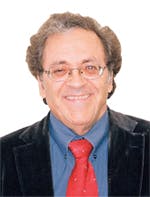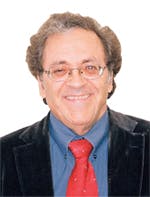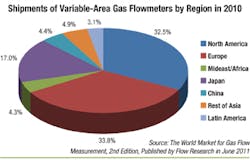While variable-area (VA) flowmeters are limited in their functionality, they cost far less than most other types of flowmeters. When users are looking for a simple, low-cost solution, VA meters are a particularly good fit. While they can measure flowrate, they are well suited for applications where a flow/no-flow determination is desired. They are also very effective at measuring low flowrates, and since they do not require electric power, they can safely be used in flammable environments.
History
The history of variable-area meters dates to 1908 when they were invented by German engineer Karl Kueppers in Aachen, Germany. At that time they were called “rotameters,” named after the rotating float that was originally a component of these meters. Felix Meyer recognized the commercial potential of Kueppers’ invention, and in 1909 founded “Deutsche Rotawerke” in Aachen. The product invented by Karl Kueppers was the first variable-area flowmeter with a rotating float.
The German company Deutsche Rotawerke was the forerunner of the company that became known as the Rota Company. Originally, Meyer called his products “rotamesser.” In 1995, Yokogawa purchased the Rota Company and named the resulting company Rota Yokogawa. Rota Yokogawa still manufactures its variable-area meters, which it also calls rotameters, in Wehr, Germany.
In the meantime, the GEC Crawley Company in Crawley, United Kingdom, began manufacturing the first glass variable-area meters, and registered the name Rotameter as a trademark in the United Kingdom. This name still exists as a trademark in the United Kingdom, but has been passed down through a number of companies, including KDG Instruments and Solartron Mobrey. In March 2009, Emerson Process Management acquired Solartron Mobrey, presumably for its level, density and flow computer products. As part of the acquisition, Emerson Process acquired the trademark to the name “rotameter” in the United Kingdom.
The terms “rotameter” and “variable-area meter” have become synonyms over the years. It appears, though, that Yokogawa has the rights to the name rotameter in Germany while Emerson Process has the rights to the name in the United Kingdom. Regardless, the name rotameter has become a generic term for variable-area flowmeters, so its status as a true trademark is open to question. This is similar to what happened to “Xerox,” which is now often used generically to describe any photocopy.
Principle of Operation
Most variable-area (VA) flowmeters consist of an upright, tapered measuring tube that contains a float. Fluid flows through the tube from bottom to top. The upward force of the fluid raises the float in the tube. The float is counterbalanced by the force of gravity. The point at which the float stays constant indicates the volumetric flowrate, which can be often read on a scale on the meter tube. Variable-area meters vary according to their float shape and from the material the float is made.
Construction
Variable-area meters come in plastic, glass and metal. Their cost varies with their material of construction. Metal-tube meters are generally highest in cost, and are designed for high-pressure and high-temperature applications. Plastic meters are typically lowest in cost, followed by glass flowmeters. Some metal tube meters can exceed $1,000 in price. A group of VA meters called purgemeters have been designed for low-flow applications.
For most plastic and glass VA meters, the flowrate can be read from the scale on the tapered meter tube. For metal VA meters, the position of the flow is magnetically transmitted to an analog indicator. These meters also have a scale indicating flowrate, and the position of the analog indicator displays the flowrate. These VA meters still rely on a float to indicate flowrate, and they also need to be read manually, like most of the tube design meters. Metal VA meters can be used for liquid, gas and steam applications.
ApplicationsPlastic meters are applicable for water, gas and air applications. The scales are separately marked for water and air applications, and they are available in both English and metric units. They are most widely used when cost is the main consideration, and high accuracy is not required.
Suppliers
KROHNE began making variable-area meters in Duisburg, Germany in 1921. Today KROHNE makes a wide range of plastic, glass and metal VA meters that can be used for a variety of applications. Some typical applications for KROHNE’s meters include hygienic and chemical processes, water and wastewater, and offshore applications. KROHNE quotes accuracies ranging from 1 percent of measured value to 4–6 percent of measured value, depending on the model.
Today Yokogawa makes a range of metal, glass, and plastic VA meters it calls the RA Series. Its metal RAMC VA meter has a transmitter that supports both HART and Profibus PA. Having a transmitter output is still the exception for most VA meters, but is becoming more common as companies want to combine the advantages of low cost with automation. In addition to indicating flow at a point in time, the RAMC has a totalizing option.
Brooks Instrument is another major supplier of variable-area meters. The company offers both low-flow and high-flow glass tube meters. The company quotes 2 percent, 3 percent, and 10 percent accuracy for its high-flow glass tube meters, depending on the model. It quotes accuracies of 5 percent and 10 percent on the low-flow glass tube meters. Brooks has a line of armored, metal-tube VA meters called the MT Series. These meters have corrosion-resistant options for metering aggressive fluids. Transmitters with 4-20mA and HART are offered as options for remote monitoring.
Blue-White Industries offers primarily acrylic and polysulfone VA meters. Polysulfone is a type of plastic that is tolerant of high temperatures. The company offers both tube and block models. The block type meters are rectangular instead of round, and are designed for panel mounting. Blue-White quotes flowrates of 0.25 to 100 gallons per minute (GPM) on some of its machined acrylic meters. The largest line size of these meters is 2 inches.
Where They Stand?
Variable-area flowmeters are considered to be traditional technology meters. They are the least expensive and least sophisticated of the traditional meters. They are relatively simple in construction when compared to a turbine or positive-displacement meter. Yet variable-area meters have maintained their market size over the years, even though this size is less than that of turbine or positive-displacement meters.
One reason why VA meters have maintained their presence in the market is that suppliers have offered improvements such as transmitter outputs, and have built VA meters designed for specific applications. This often means choosing particular materials of construction, along with a different shaped tube or float. This increases the versatility of VA meters and makes them more appealing to end-users with specific needs.
Another reason for their growth is that they fill a genuine need in the market. In some cases end-users simply need a flow/no-flow indication, or they are satisfied with 2 percent or 5 percent accuracy. Variable-area meters may also do well in regions where cost is a major consideration and high accuracy is not always required. Depending on application, VA meters may do well in China, India, Australia, Malaysia, and Indonesia. KROHNE is positioned to supply these regions with its variable-area manufacturing facility in Chengde, China. Another major VA supplier positioned to sell into the Asian region is Tokyo Keiso of Japan.
Variable-area meters have a fascinating past, and they could have a bright future. How bright their future will be depends on how much research and development suppliers decide to put into them. By incorporating more advanced features such as transmitter outputs, more varied materials of construction, different float designs, and more industry approvals, VA suppliers can potentially position themselves for expansion. At the moment, much research and development money is going into Coriolis and ultrasonic meters. That is not likely to change, but if VA suppliers can continue to improve their products and develop higher accuracies, the variable-area flowmeter market has a chance to expand.
Jesse Yoder, Ph.D., is president of Flow Research Inc. in Wakefield, Mass., a company he founded in 1998. He has 24 years of experience as an analyst and writer in process control. Dr. Yoder specializes in flowmeters and other field devices, including pressure and temperature products. He has written over 150 journal articles on instrumentation topics. Dr. Yoder can be reached at [email protected].
For more information on Flow Research’s research in the area of variable-are flow measurement, see FlowVA.com.




